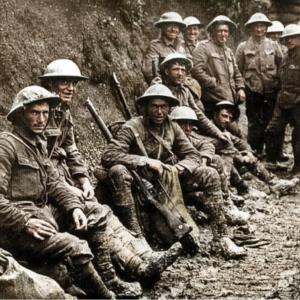
On this day in military history…
The final day of the Battle of the Somme was 18 November 1916. It had begun on 1 July 1916. That means the battle had lasted 141 days. It had become the largest and most sustained battle ever fought by the British Army up to that time, and the conditions and the situation on the final day tell us exactly why it ended on that date.
By November winter was closing in. The ground across the Somme had turned into deep mud, especially after the heavy rain of October. Later photos and many soldiers’ diaries describe the mud as more like a liquid than soil. Men and horses could literally sink in it. Machinery jammed in it and shells that were supposed to explode simply plunged into wet soil and failed to detonate. One British soldier said that simply walking to the front line was like crossing fields of porridge.
The attack of 18 November 1916 was not large and in many ways was almost symbolic. The British attempted a final push around the Ancre area near the village of Grandcourt. There were small local gains, mainly by the 51st Highland Division, and some German positions were taken, but it was nothing decisive. The weather and the mud meant it was impossible to launch the kind of high-tempo supporting attacks that would be needed to exploit any local success. The fighting had simply reached the point where nature itself was stopping the battle as much as the German Army was.
What forced the end was a combination of strategic and physical factors. British commanders had to admit that more large attacks would achieve very little. They were also now planning for the coming operations in 1917. And behind the German lines there were already plans forming to pull back to a new and more compact defensive position further east: the Hindenburg Line. The ground gained by the Allies on the Somme could only be held with enormous difficulty through winter, and it was judged better to pause, consolidate trenches and shelters, rotate exhausted units, and prepare for next year’s war.
The cost of the battle was extreme. British and Empire forces suffered roughly 420,000 casualties. The French suffered around 200,000. German casualties are generally calculated at roughly 430,000 to 465,000. That means total losses on both sides were well over one million men in four and a half months. All of this gained the Allies roughly six to seven miles of ground at the deepest points.
The immediate aftermath was a winter of misery in the trenches. Fighting continued in smaller local actions, but the great phase of attack was over. In early 1917 the German Army, as planned, pulled back to the Hindenburg Line and shortened their front by around 25 miles. This created stronger defensive conditions for Germany and meant much of the ground won at such dreadful cost now faced empty space rather than the enemy. It was a reminder of how stubborn trench warfare could nullify effort.
The Battle of the Somme ended when weather, exhaustion and limited strategic returns combined to make further attacks pointless. Its end was not a victory for one side or the other, but rather an enforced pause. It has remained a symbol of the nature of the First World War: that in 1916 massive effort and almost unimaginable sacrifice still could not produce a breakthrough.










